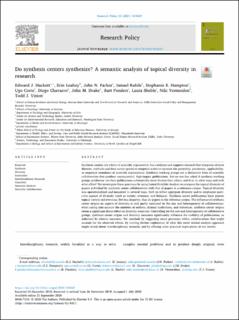| dc.contributor.author | Hackett, Edward J. | |
| dc.contributor.author | Leahey, Erin | |
| dc.contributor.author | Parker, John N. | |
| dc.contributor.author | Rafols, Ismael | |
| dc.contributor.author | Hampton, Stephanie E. | |
| dc.contributor.author | Corte, Ugo | |
| dc.contributor.author | Chavarro, Diego | |
| dc.contributor.author | Drake, John M. | |
| dc.contributor.author | Penders, Bart | |
| dc.contributor.author | Sheble, Laura | |
| dc.contributor.author | Vermeulen, Niki | |
| dc.contributor.author | Vision, Todd J. | |
| dc.date.accessioned | 2021-02-15T15:05:31Z | |
| dc.date.available | 2021-02-15T15:05:31Z | |
| dc.date.created | 2021-01-11T21:29:21Z | |
| dc.date.issued | 2020-09 | |
| dc.identifier.citation | Hackett, E., Leahey, E., Parker, J.N. et al. (2020) Do synthesis centers synthesize? A semantic analysis of topical diversity in research. Research Policy, 50(1), 104069. | en_US |
| dc.identifier.issn | 0048-7333 | |
| dc.identifier.uri | https://hdl.handle.net/11250/2728198 | |
| dc.description.abstract | Synthesis centers are a form of scientific organization that catalyzes and supports research that integrates diverse theories, methods and data across spatial or temporal scales to increase the generality, parsimony, applicability, or empirical soundness of scientific explanations. Synthesis working groups are a distinctive form of scientific collaboration that produce consequential, high-impact publications. But no one has asked if synthesis working groups synthesize: are their publications substantially more diverse than others, and if so, in what ways and with what effect? We investigate these questions by using Latent Dirichlet Analysis to compare the topical diversity of papers published by synthesis center collaborations with that of papers in a reference corpus. Topical diversity was operationalized and measured in several ways, both to reflect aggregate diversity and to emphasize particular aspects of diversity (such as variety, evenness, and balance). Synthesis center publications have greater topical variety and evenness, but less disparity, than do papers in the reference corpus. The influence of synthesis center origins on aspects of diversity is only partly mediated by the size and heterogeneity of collaborations: when taking into account the numbers of authors, distinct institutions, and references, synthesis center origins retain a significant direct effect on diversity measures. Controlling for the size and heterogeneity of collaborative groups, synthesis center origins and diversity measures significantly influence the visibility of publications, as indicated by citation measures. We conclude by suggesting social processes within collaborations that might account for the observed effects, by inviting further exploration of what this novel textual analysis approach might reveal about interdisciplinary research, and by offering some practical implications of our results. | en_US |
| dc.language.iso | eng | en_US |
| dc.publisher | Elsevier Ltd. | en_US |
| dc.rights | Navngivelse 4.0 Internasjonal | * |
| dc.rights.uri | http://creativecommons.org/licenses/by/4.0/deed.no | * |
| dc.subject | forskning | en_US |
| dc.title | Do synthesis centers synthesize? A semantic analysis of topical diversity in research | en_US |
| dc.type | Peer reviewed | en_US |
| dc.type | Journal article | en_US |
| dc.description.version | publishedVersion | en_US |
| dc.rights.holder | © 2020 The Authors | en_US |
| dc.subject.nsi | VDP::Samfunnsvitenskap: 200 | en_US |
| dc.source.pagenumber | 13 | en_US |
| dc.source.volume | 50 | en_US |
| dc.source.journal | Research Policy | en_US |
| dc.identifier.doi | 10.1016/j.respol.2020.104069 | |
| dc.identifier.cristin | 1869428 | |
| dc.source.articlenumber | 104069 | en_US |
| cristin.ispublished | true | |
| cristin.fulltext | original | |
| cristin.qualitycode | 2 | |

